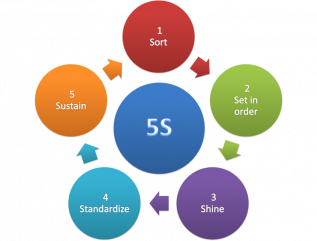Article Summary
5S is a lean tool that is utilized to reduce waste and maximize efficiency. 5S implementation can be beneficial to an organization in terms of improved quality, reduced costs, standardizing work processes and financial gains. Manufacturing has been linked as the origination of 5S. 5S developed in Japan combines workplace organization through the use of efficiency, effectiveness and safety [1]. It has evolved to other sectors such as healthcare, service and office settings.
The intent of discovering 5S manufacturing failure connects to other industries that share the same concerns of reducing costs, standardizing processes and improved quality. 5S is beneficial when it is successfully implemented and sustainable. When 5S fails the barriers that cause the failure must be determined to understand the failure of 5S in a manufacturing workplace. The barriers can occur at any of the 5S stages and thus the outcome of a failed 5S project needs direction on what stage it fails and what actions are needed following a failed 5S project. Identification of barriers that lead to 5S project failure will determine the effectiveness of the 5S stages.
Definition of 5S as a success or failure
5S failure requires a definition of what a failed project is. To understand what a failed project is, a successful 5S project should be defined. There are many cases of successful results of 5S.
The US Bureau of Economic Analysis conducted a study in 2011 on the value-added dollar of manufacturing represented 12.2 per cent of industries in the US. In 2015 the Center for Automotive Research released a report that revealed 5S tools and lean continuous improvement methods contributed to $500 billion annual compensation of 1.5 million automotive jobs. [2]. Financial drivers are the underlining focus of many 5S projects.
The development of 6S
5S success has led to the incorporation of adding Safety as the 6S. A case study on Medium and Micro-Small enterprises created a paperless system and a sustainable waste recycling program making the outcomes of the project a success.
Process improvements and addressing safety were the main concerns for utilizing 5S. This study eliminated waste processes and also introduced safety factors such as better hygienic conditions, eco-friendly waste disposal practice and improved housekeeping methods. 5S integrated into 6S with the sixth S being safety. [3].
Lean popularity
Lean had gained popularity that spread through manufacturing. Many manufacturing organizations began to jump on the lean bandwagon utilizing tools such as 5S, Poka-Yoke, Kanban systems, just-in-time and Kaizen events as they followed suit of what other organizations were attaining. A case study by The Industry Week/MPI Census of Manufacturers resulted in 70% of plants in the U.S is utilizing a form of lean manufacturing as an improvement method. The study did not focus on if lean was the correct tool for the organizations.
A further look at the same IW/MPI survey displays that only 2% of companies who responded to the survey have fully achieved their objectives and less than a quarter of all companies, 24% reported achieving significant results. That leaves 74% of the responding companies admitting that they are not making good progress with Lean [4]. A successful 5S project is one that is repeatable over time without any diminished effects.
Motives & problems
There are numerous motives for implementation of 5S as there are explanations why 5S fails to deliver the results for a manufacturing organization. The main problems associated with sustaining 5S provides knowledge to quality professionals for understanding 5S. The importance of the investigation is to understand how 5S works so well for one organization and not for another. As a baseline tool in lean concepts, 5S is what many consider the introduction on the start of a lean journey [5].




